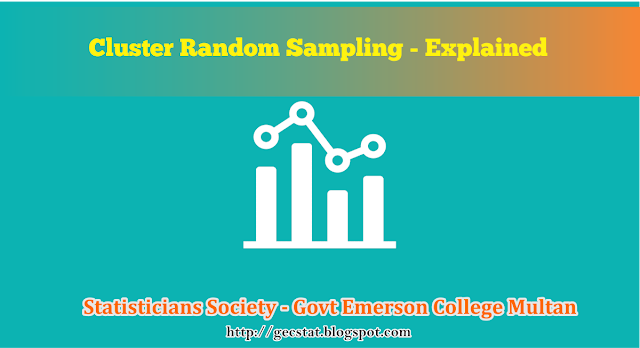Cluster and Multistage Sampling
Cluster sampling is the sampling method where different groups
within a population are used as a sample. This is different from stratified
sampling in that you will use the entire group, or cluster, as a sample rather
than a randomly selected member of all groups.
Sometimes stratifying isn’t practical and simple random sampling is
difficult. Splitting the population into similar parts or clusters can make
sampling more practical. Then we could select one or a few clusters at random
and perform a census within each of them. This sampling design is called
cluster sampling. If each cluster fairly represents the full population,
cluster sampling will give us an unbiased sample. Cluster sampling is not the
same as stratified sampling. We stratify to ensure that our sample represents
different groups in the population, and sample randomly within each stratum.
Following steps are included in cluster random sampling:-
STEPS IN CLUSTER RANDOM SAMPLING:
1. Identification of
population
In order to do cluster random
sampling, first we have to identify the population. In this step we choose a
proper population for our sampling and then define our population in terms of
our sampling purposes. It is to be assured that the population has a proper
identification and definition, otherwise we may face some errors in our output
results.
For example we select a country (say Pakistan) as our population to
do a survey by the students about education system. All the students from all over
Pakistan will be a population.
2. Determining desired
sample size
Determining sample
size is a key step in sampling. Sample size must not be such bigger that it
contains almost all the population units, and not much smaller that it could
not represent the whole population properly. Sample size must be 1/3 of the
population.
3. Identification of logical
cluster
Clusters
are more or less alike, each heterogeneous and resembling the overall
population. In order to make sampling more effective & accurate, we divide the sampling frame into different clusters. Clusters
are heterogeneous internally & homogeneous as compare to other clusters. As
only a sample of clusters are sampled, the ones selected need to represent the
ones unselected; this is best done when the clusters are as internally
heterogeneous in the survey variables as possible. We then identify &
define a logical cluster in belief that this will represent all the clusters of
the population.
4. Listing all
clusters
After making clusters from the
population, all clusters are listed to make up
population of the clusters. For example Lahore, Islamabad, Multan,
Karachi & Faisal Abad have been made as clusters, then the all clusters
will be listed and a population will be made by studying the all listed
clusters.
5. Estimating of
population numbers
Population can’t be predicted as
accurate before sampling, however the population is estimated on the basis of
clusters. In order to find out the population of the clusters, the average number
of population members per cluster is taken. In order to find average, the
population of a single cluster is divided by the all clusters population.
6. Determining the
number of clusters
After estimating
the average number of population members per cluster, we determine the number
of clusters needed by dividing the sample size by the estimated size of a
cluster. In this step we choose, how much clusters will be included in sampling
process. Numbers of clusters are selected to make sure that those clusters will
represent the other population of their area. Number of cluster must not be
larger & not be much smaller.
7. Selecting the
clusters randomly
We select clusters to make sampling more
practical or affordable. Selecting the cluster is a main step included in
sampling. After the determination of number of clusters to select, the next
step is to select needed numbers of clusters from all the list of clusters. Clusters
are selected randomly without any biasness. Clusters can be selected randomly
by using any method of selecting randomly, which are random table, bowl method
& lucky draw method.
8. Including all
members in population of cluster
After selecting
the clusters randomly, the next step is to study all the members of the
population of those clusters. The sample study included in all population members in
each selected cluster. Within the
cluster each & every member of that cluster is studies completely without
missing any single member.
Stratification Vs. Clustering
Stratification:
1. In
stratification, population is divided into groups which are different from each
others. For example, sexes, ages, races.
2.
In stratification,
sample is selected randomly from each group.
3.
Stratification
has less error as compare to simple random sampling.
4.
Stratification
has more cost & is expensive when obtaining stratification information before
the sampling
Clustering:
1.
In
clustering, population is divided into groups which are comparable to each
others. For example, Schools, Cities.
2.
In clustering,
sample is selected randomly from some of the groups, not from each group.
3.
Clustering
has more error as compare to simple random sampling.
4.
Clustering
has less cost, as some areas or organizations are used as sample, which is less
expensive.



0 Comments